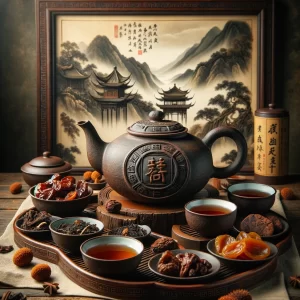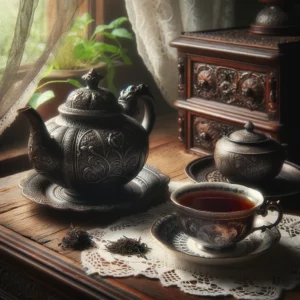Aged Pu-erh Tea, with its deep, earthy flavors and rich history, stands as a fascinating subject for anyone interested in the wide world of teas. This special kind of tea is not just a drink but a journey through centuries-old traditions, offering a unique taste that improves with time, much like a fine wine. In this blog post, we’ll explore everything from the ancient origins of Aged Pu-erh Tea to the art of brewing the perfect cup, aiming to provide tea lovers and newcomers alike with in-depth knowledge about this remarkable tea.
Brief Description
Discover the world of Aged Pu-erh Tea, a tea like no other, celebrated for its complex flavors and ancient heritage. This comprehensive guide takes you on a journey through the origins, special brewing techniques, and cultural significance of Aged Pu-erh Tea, providing insights into how to savor this timeless treasure.
Table of Contents
- The Origins and History of Aged Pu-erh Tea
- What Makes Aged Pu-erh Tea Special?
- Brewing the Perfect Cup of Aged Pu-erh
- Different Ways to Enjoy Aged Pu-erh Tea
- The Best Pairings for Aged Pu-erh Tea
- Where to Find and How to Store Aged Pu-erh Tea
- The Cultivation and Processing of Aged Pu-erh Tea
- Conclusion
The Origins and History of Aged Pu-erh Tea
Aged Pu-erh Tea hails from the Yunnan province of China, a region renowned for its ancient tea trees. The tradition of Pu-erh tea dates back thousands of years, originally consumed by ethnic minorities in China before gaining popularity across the country and then the world. The tea’s name comes from the Pu’er city in Yunnan, which was a bustling trade center for tea in ancient times.
Facts about Aged Pu-erh Tea History:
- Origin: Yunnan province, China.
- Discovery: Used for centuries by ethnic groups in China.
- Popularity: Grew from a local specialty to a globally cherished tea.
Pu-erh tea’s unique aging process, where the leaves undergo fermentation after drying and rolling, contributes to its distinct flavor profile. Historically, this tea was a form of currency, transported on horseback along the ancient Tea Horse Road, influencing cultures far beyond China’s borders.
What Makes Aged Pu-erh Tea Special?
Aged Pu-erh Tea is distinguished by its fermentation process and the aging period that follows. Unlike other teas, Pu-erh can be aged for decades, during which its flavor, aroma, and color deepen and improve.
Key Characteristics:
- Fermentation: A natural process that enhances the tea’s complexity.
- Aging Potential: Can be aged like wine, improving with time.
- Flavor Profile: Ranges from earthy and woody to sweet and floral, depending on age and processing.
This tea is available in two main types: raw (Sheng) Pu-erh, which naturally ages over time, and ripe (Shou) Pu-erh, which undergoes a faster, controlled fermentation to mimic the aging process. This diversity allows tea enthusiasts to explore a wide range of flavors.
Brewing the Perfect Cup of Aged Pu-erh
Brewing Aged Pu-erh Tea is an art form, requiring patience and a bit of knowledge to unlock its full potential. Here’s a simple guide to get you started:
- Select Your Tea: Choose between raw or ripe Pu-erh based on your flavor preference.
- Measure the Right Amount: Typically, use about 3-5 grams of tea for every 6 ounces of water.
- Heat Your Water: Aim for a temperature of 200-212°F (93-100°C), depending on how strong you like your tea.
- Rinse the Leaves: Pour hot water over the leaves, then quickly discard this water to “wake up” the tea.
- Steep Your Tea: Let the tea steep for a few seconds to several minutes, tasting frequently to find your perfect brew.
Tips:
- Experiment with steeping times to discover different flavor nuances.
- Aged Pu-erh can be re-steeped multiple times, with each infusion revealing a new layer of flavor.
Different Ways to Enjoy Aged Pu-erh Tea
Aged Pu-erh Tea can be enjoyed in many forms, from a simple, soothing cup to complex recipes that showcase its versatility.
- Straight: Savor the tea on its own to fully appreciate its depth.
- With Additions: Experiment with adding lemon, honey, or milk to adjust the flavor to your liking.
- In Recipes: Use brewed Pu-erh as a base for soups, marinades, or even desserts for a unique twist.
Cultural significance plays a big part in how Pu-erh is enjoyed, especially in China, where it is often consumed during or after meals to aid digestion.
The Best Pairings for Aged Pu-erh Tea
The robust flavors of Aged Pu-erh Tea pair wonderfully with various foods. Here are some suggestions to enhance your tea-drinking experience:
- Savory Dishes: Dim sum, roasted meats, or mushroom dishes complement the earthiness of Pu-erh.
- Sweet Treats: Dark chocolate or fruit-based desserts can balance the tea’s richness.
- Cheese: Aged cheeses pair well with the complex flavors of Pu-erh.
Experimenting with different pairings will help you discover the perfect match for your palate.
Where to Find and How to Store Aged Pu-erh Tea
Finding quality Aged Pu-erh Tea requires knowing what to look for and where to look. Specialty tea shops, online retailers, and Asian markets are good places to start. When selecting Pu-erh, consider the age, appearance, and smell of the tea.
Storage Tips:
- Keep your tea in a cool, dry place away from strong odors.
- Pu-erh prefers a bit of air, so don’t seal it too tightly.
- Avoid storing it in direct sunlight to preserve its flavor and aroma.
Proper storage is key to allowing Aged Pu-erh Tea to continue maturing and developing its character.
The Cultivation and Processing of Aged Pu-erh Tea
The journey of Aged Pu-erh Tea from leaf to cup is a complex process involving careful cultivation and meticulous processing. The tea trees in Yunnan, some of which are hundreds of years old, provide the raw material for Pu-erh tea. After plucking, the leaves undergo a series of steps:
- Withering: Reduces moisture content and prepares leaves for rolling.
- Rolling: Breaks down the leaves to release enzymes and flavors.
- Fermenting: Either through natural aging (raw Pu-erh) or accelerated fermentation (ripe Pu-erh).
- Drying: Stops fermentation and prepares the tea for aging.
Each step is crucial in shaping the final taste, aroma, and quality of Aged Pu-erh Tea.
Conclusion
Aged Pu-erh Tea offers a unique window into the rich tapestry of tea culture, providing an experience that’s both profoundly historical and deeply personal. From its ancient roots in Yunnan to the meticulous process of aging that transforms its flavors, Pu-erh tea is a testament to the art of tea making. We encourage you to explore the depths of Aged Pu-erh Tea, experimenting with brewing techniques, pairings, and even the ways you enjoy it. In doing so, you’ll not only discover the nuances of this exceptional tea but also connect with a tradition that has captivated tea lovers for centuries.




